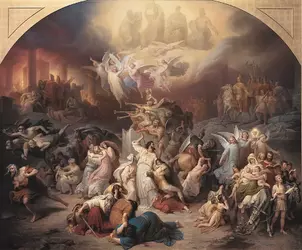- Joined
- Aug 30, 2015
Navigation
Install the app
How to install the app on iOS
Follow along with the video below to see how to install our site as a web app on your home screen.
Note: This feature may not be available in some browsers.
More options
Style variation
You are using an out of date browser. It may not display this or other websites correctly.
You should upgrade or use an alternative browser.
You should upgrade or use an alternative browser.
Last Image You Saved - we all know it's hentai
- Thread starter sadstuck
- Start date
-
🐕 I am attempting to get the site runnning as fast as possible. If you are experiencing slow page load times, please report it.
- Joined
- Jun 20, 2024
Ventrue
kiwifarms.net
- Joined
- Oct 31, 2023
The Destruction of Jerusalem by Titus, by Wilhelm von Kaulbach completed in 1846.
In 1943, during the bombing of Berlin in World War II the painting was damaged, years later it was restored.

The painting depicts the destruction of Jerusalem in AD 70 by Titus who commanded four legions, totaling over 60,000 men during the First Jewish–Roman War, which began in AD 66 as a rebellion against Roman rule. At the bottom left an old man is seen fleeing from the chaos. His name is Ahasuerus, The Wandering Jew. The mythical medieval story about a Jew who taunted Jesus on the way to the Crucifixion was then cursed to walk the Earth until the Second Coming.
In 1943, during the bombing of Berlin in World War II the painting was damaged, years later it was restored.

The painting depicts the destruction of Jerusalem in AD 70 by Titus who commanded four legions, totaling over 60,000 men during the First Jewish–Roman War, which began in AD 66 as a rebellion against Roman rule. At the bottom left an old man is seen fleeing from the chaos. His name is Ahasuerus, The Wandering Jew. The mythical medieval story about a Jew who taunted Jesus on the way to the Crucifixion was then cursed to walk the Earth until the Second Coming.
It remains one of the most ambitious visual interpretations of a biblical event ever painted. It’s not merely about a military victory; it’s a canvas teeming with moral collapse and eternal truths. At the heart of the painting lies the idea of divine judgment.
Titus, while a Roman general, is portrayed almost as an Old Testament instrument of wrath—akin to Nebuchadnezzar in the Book of Daniel. The destruction of the Second Temple becomes more than a military victory; it is a spiritual reckoning.
This theme would have resonated deeply with 19th-century Germans, who often saw biblical history as a mirror to their own national destiny. For them, disobedience to divine law had consequences—whether ancient Jerusalem or modern Europe.
The message is unmistakable: societies that lose their moral compass invite destruction. Jerusalem, in Kaulbach’s hands, becomes a metaphor for any civilization that abandons its divine mandate. The painting doesn’t celebrate Roman power it laments the tragedy of spiritual decline. This sober and conservative reading of history, common in the Protestant monarchies of the time, is embedded in every brushstroke of the mural.
Titus, while a Roman general, is portrayed almost as an Old Testament instrument of wrath—akin to Nebuchadnezzar in the Book of Daniel. The destruction of the Second Temple becomes more than a military victory; it is a spiritual reckoning.
This theme would have resonated deeply with 19th-century Germans, who often saw biblical history as a mirror to their own national destiny. For them, disobedience to divine law had consequences—whether ancient Jerusalem or modern Europe.
The message is unmistakable: societies that lose their moral compass invite destruction. Jerusalem, in Kaulbach’s hands, becomes a metaphor for any civilization that abandons its divine mandate. The painting doesn’t celebrate Roman power it laments the tragedy of spiritual decline. This sober and conservative reading of history, common in the Protestant monarchies of the time, is embedded in every brushstroke of the mural.
- Joined
- Sep 15, 2024
- Joined
- Oct 3, 2018
- Joined
- Feb 14, 2025
- Joined
- Mar 25, 2024
- Joined
- Jan 9, 2020
- Joined
- Sep 29, 2018
- Joined
- Jan 4, 2021
- Joined
- Aug 30, 2015
Papa stink
kiwifarms.net
- Joined
- Jan 15, 2020
- Joined
- Aug 29, 2018
- Joined
- Nov 15, 2017
- Joined
- Sep 15, 2024
- Joined
- Dec 22, 2021
1000 posts reached today
- Joined
- Mar 25, 2024
ditto
kiwifarms.net
- Joined
- Aug 17, 2019
- Joined
- Jan 23, 2020
- Joined
- Nov 15, 2017













